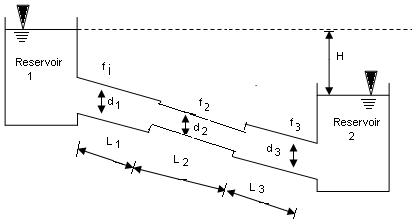Pipe In Series
Pipe In Series Assignment Help | Pipe In Series Homework Help
Pipe In Series
• When the pipes of different lengths and diameters are connected to each other to form a pipeline the such a pipeline is called as a compound pipe or pipes in series.
• As the pipes are in series, the discharge through each pipe will be same (continuous)
Q = A1 V1 = A2 V2 = A3 V3
• If a pipeline connecting two reservoirs by compound pipes, then the difference in liquid surface level is equal to the sum of the head losses in all the sections.

Let Q = discharge through pipeline
H = total loss of head
d1 = diameter of pipe 1
L1 = length of pipe 1
f1 = friction factor
d2, ι2, f2 = corresponding value of pipe 2,
d3, ι3, f3 = corresponding value of pipe 3.
1. Considering all losses,
Total loss of head = Major losses + Minor losses
H = hL1+ hL2
Major losses = head loss due to friction in each pipe
hL1 = hf1 + hf2 + hf3
hL1 = f1 L1 V12 / 2g d1 + f2 L2 V22 / 2g d2 + f3 L3 V2 / 2g d3
Minor losses = Entrance + Contraction + Expansion + Exit
loss loss loss loss
hL2 = 0.5 V12/ 2g + 0.5 V22 / 2g + (V2 - V3)2 / 2g + V32 / 2g
2. If minor losses are neglected, then
Total loss of head = Major losses
H = 1/2g [f1L1V12 / d1 + f2L2V22/d2 + f3L3V32/d3
3. If discharge through the pipe is given, then
H = f1L1Q2/12.1d15 + f2L2Q2/12.1d25 + f3L3Q2/12.1d35
For more help in Pipe In Series click the button below to submit your homework assignment
• As the pipes are in series, the discharge through each pipe will be same (continuous)
Q = A1 V1 = A2 V2 = A3 V3
• If a pipeline connecting two reservoirs by compound pipes, then the difference in liquid surface level is equal to the sum of the head losses in all the sections.
Let Q = discharge through pipeline
H = total loss of head
d1 = diameter of pipe 1
L1 = length of pipe 1
f1 = friction factor
d2, ι2, f2 = corresponding value of pipe 2,
d3, ι3, f3 = corresponding value of pipe 3.
1. Considering all losses,
Total loss of head = Major losses + Minor losses
H = hL1+ hL2
Major losses = head loss due to friction in each pipe
hL1 = hf1 + hf2 + hf3
hL1 = f1 L1 V12 / 2g d1 + f2 L2 V22 / 2g d2 + f3 L3 V2 / 2g d3
Minor losses = Entrance + Contraction + Expansion + Exit
loss loss loss loss
hL2 = 0.5 V12/ 2g + 0.5 V22 / 2g + (V2 - V3)2 / 2g + V32 / 2g
2. If minor losses are neglected, then
Total loss of head = Major losses
H = 1/2g [f1L1V12 / d1 + f2L2V22/d2 + f3L3V32/d3
3. If discharge through the pipe is given, then
H = f1L1Q2/12.1d15 + f2L2Q2/12.1d25 + f3L3Q2/12.1d35
For more help in Pipe In Series click the button below to submit your homework assignment